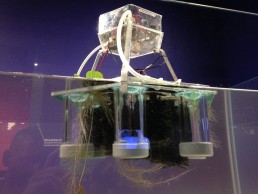CARAVEL
Ivan Henriques (Brasil)
RIO DE JANEIROEXPOSIÇÃO | EXBITHION
Oi Futuro FlamengoGaleria 1 – Nível 2 | Gallery 1 – Level 2
obra | work
Para avançar um pouco mais sobre a evolução do projeto Symbiotic Machine, ‘Caravel’ é criado neste projeto. Ele usa tecnologia de célula de combustível microbiana (MFC) para colher eletricidade de bactérias anaeróbicas e componentes orgânicos na água. A forma hexagonal tem a função de combinar e unir outros Caravels para criar uma superfície maior e operar como um enxame. Caravel tem uma grande estrutura hexagonal, consistindo de um conjunto de 13 hexágonos menores e 6 trapezoides. Os trapezoides são recipientes para plantas aquáticas. Algumas plantas de água são invasivas, mas algumas delas têm a capacidade de filtrar a água, ou seja, Pistia. Dentro dos trapeços, as plantas estão em um sistema controlado que impedirá a proliferação em toda a superfície da água e, ao mesmo tempo, ajudará na filtragem junto com o MFC. Os seis hexágonos menores na borda são flutuadores. Os outros sete colocados no centro são as baterias orgânicas e os dispositivos de filtragem. No contexto da WATER.WAR e em colaboração com os cientistas da LabMET, Faculdade de Bio-Engenharia da Universidade de Ghent, Ivan Henriques desenvolveu uma estrutura robotizada móvel flutuante que colhe e armazena sua energia a partir de Pilhas de Combustível Microbianas. As células de combustível microbianas, ou MFC, são dispositivos que usam bactérias nas águas residuais como catalisadores para oxidar a matéria orgânica e gerar eletricidade.A energia colhida dos MFC é aplicada para mover a estrutura robótica e, ao mesmo tempo, para limpar o ambiente poluído com a ajuda de plantas purificadoras de água integradas na estrutura. O desenvolvimento deste protótipo faz parte da evolução das bio-máquinas construídas anteriormente pelo artista Ivan Henriques, que são formas híbridas entre organismos vivos e máquinas criando um vetor evolutivo entre máquinas e natureza.
In order to move one step further on the evolution of the project Symbiotic Machine, ‘Caravel’ is created in this project. Caravel uses Microbial Fuel Cell (MFC) technology to harvest electricity from anaerobic bacteria and organic components in the water. The hexagonal form has the function to exactly match and join other Caravels to create a bigger surface and operate as a swarm. Caravel has a big hexagonal frame, consisting a set of 13 smaller hexagons and 6 trapezoids. The trapezoids are containers for water plants. Some water plants are invasive, but some of them have the ability to filter the water, i.e. Pistia. Inside the trapezoids, the plants are in a controlled system which will prevent them to proliferate in the whole water surface, and at the same time help in the filtering together with the MFC. The six smaller hexagons on the edge are floaters. The other seven placed in the centre are the organic batteries and filtering devices. In the context of WATER.WAR and in collaboration with the scientists of LabMET, Faculty of Bio-Engineering at the University of Ghent, Ivan Henriques developed a floating mobile robotic structure which harvests and stores it’s energy from Microbial Fuel Cells. Microbial Fuel Cells, or MFC’s, are devices that use bacteria in waste water as the catalyst to oxidise organic matter and generate electricity. The energy harvested from the MFC’s is applied to move the robotic structure and at the same time to clean the polluted environment with the help of water-purifying plants integrated in the structure. The development of this prototype is part of the evolution of bio-machines previously built by artist Ivan Henriques, which are hybrid forms between living organisms and machines creating an evolutionary vector between machines and nature.
bio
Ivan Henriques é um artista transdisciplinar e pesquisador que trabalha em instalações multimídia examinando sistemas vivos. Ele explora, em seus trabalhos, híbridos da natureza e cultura (tecnológica) criando novas formas de comunicação entre humanos e outros organismos vivos. Considera a natureza como inspiração e um fator necessário para o desenvolvimento do mundo tecnológico. Ivan desenvolveu o grupo interdisciplinar formas híbridas e é o diretor do programa de residência móvel EME >> (Estúdio Móvel Experimental, desde 2008). Seus trabalhos são exibidos internacionalmente, participando de festivais, residências e palestras.
Ivan Henriques is a transdisciplinary artist and researcher working in multimedia installations examining living systems. He explores in his works hybrids of nature and (technological) culture creating new forms of communication between humans and other living organisms. He considers nature as inspiration and a necessary factor in the development of the technological world. Ivan developed the interdisciplinary group Hybrid Forms and is the director of the mobile residency program EME>> (Estúdio Móvel Experimental, since 2008). His works are exhibited internationally, participating in festivals, residencies and talks.

